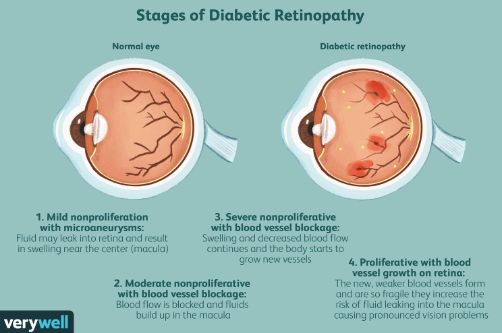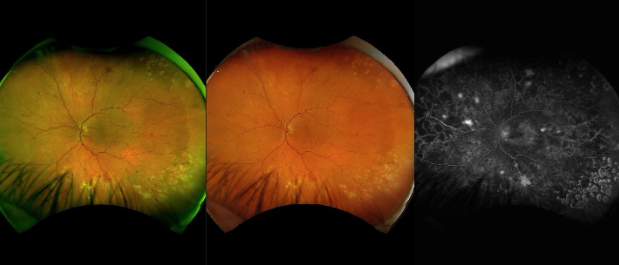The Importance of Diabetic Eye Screening
Diabetes is a condition that prevents the body from using and storing sugar properly. As a result, excessive amounts of sugar remain in the bloodstream and if uncontrolled, can cause damage to the tiny blood vessels all over the body, including those in your eyes.
Diabetic retinopathy affects 30 percent of people with diabetes.
Diabetic retinopathy occurs when the blood vessels inside the eye start to leak blood and fluid into the retina, causing damage and permanent vision loss. Early detection and treatment is crucial for preserving your eyesight.
Diabetic macular edema (DME) is a complication of diabetic retinopathy and occurs when the macula, the center of the retina, begins to swell. The macula is responsible for your central and color vision. When the macula swells, it damages the blood vessels, causing them to leak— resulting in vision loss.
Patients with uncontrolled blood sugar levels have a higher risk of diabetic retinopathy.
For this reason, eye doctors recommend annual eye exams and screening with retinal imaging, is for early detection of the disease, and increased optimal treatment results. By regularly monitoring your ocular health, you are ensuring that any changes that occur will be detected early.
How is a diabetic eye exam different from a regular eye exam?
Diabetic eye exams are like regular eye exams in many ways. However, during a diabetic eye exam, your eye doctor will specifically focus on the health of your retina and integrity of the blood vessels in your eye. The standard of care for diabetic eye exam requires pupil dilation for a clear view of the inner structures of your eye — specifically, your retina, optic nerve, and blood vessels.
Your eye doctor will dilate your pupils by inserting special eye drops into your eye. The eye drops take about 30 minutes to work, and typically cause temporary blurred near vision and light sensitivity. These side effects generally subside within a few hours.
In some cases, after a retinal exam, additional tests will be recommended for further examination, such as retinal imaging with an optomap-enabled device, fluorescein angiography or optical coherence tomography.
When do I need a diabetic eye exam or diabetic eye screening?
An annual comprehensive eye exam can be part of your annual healthcare routine to help detect diabetic eye disease as soon as possible. After your initial eye exam, your eye doctor may recommend annual exams for continued monitoring of your ocular health. If your eye doctor detects any changes during an exam, you may be required to return for additional eye exams more than once every year.
Why are diabetic eye exams important for patients with diabetes?
The critical challenge with diabetic retinopathy is that retinal damage often begins long before symptoms ever develop. As such, individuals with diabetes could be heading toward vision loss without even knowing.
Diabetic retinopathy is one of the leading causes of vision loss and blindness around the globe, and affects approximately one-third of people with diabetes. Because the number of people with diabetes is expected to rise to more than 438 million worldwide by 2030, it can be assumed that the prevalence of diabetic retinopathy can be expected to rise, as well.
In addition, it’s not always possible to reverse tissue damage and/or vision loss that occurs due to diabetic retinopathy. However, with appropriate diagnosis and treatment, eyecare professionals may be able to help prevent further deterioration. For this reason, early detection of diabetic retinopathy is critical.

How diabetes affects your eyes
Diabetes impairs the body’s ability to control blood sugar. Because sugar can promote inflammation, a person with diabetes may experience inflammatory damage to various tissues within their body, including the retina, which is located on the inside back of your eye. High blood sugar causes damage to the blood vessels in the retina, where the small blood vessels that supply blood to their retinal tissue become leaky and irritated. Over time, this can lead to complete vision loss if not treated properly.
How can you tell if diabetes is affecting your eyes?
Diabetes can affect your eyes in various ways, and some of these effects may not cause noticeable symptoms in the early stages. However, as diabetes-related eye conditions progress, you may experience certain signs and symptoms that indicate potential eye problems. Here are some common ways to tell if diabetes is affecting your eyes:
-
-
Blurred Vision
-
Floaters and Flashes
-
Dark or Empty Spots
-
Difficulty Seeing at Night
-
Color Vision Changes
-
Eye Pain or Discomfort
-
Vision Changes That Fluctuate
-
Loss of Central Vision
-
Vision Distortions
-
Vision Loss
-
How quickly can diabetes affect your eyes?
Diabetes can affect your eyes at any stage of the disease, but the speed and severity of its impact on your eyes can vary widely based on several factors. These factors include the type of diabetes you have (Type 1 or Type 2), how well your diabetes is controlled, how long you've had diabetes, and your overall health.

Image courtesy of VeryWell
Conclusion
Regular comprehensive eye exams are crucial for detecting and managing diabetic eye issues. Diabetic retinopathy, for example, can often be treated more effectively if caught early. At Optos, our technology facilitates the early detection, management, and effective treatment of disorders and diseases evidenced in the retina such as diabetic retinopathy. More than 2,500 published and ongoing clinical trials as well as thousands of case studies and testimonials show the long-term value of optomap imaging in diagnosis, treatment planning, and patient engagement in diabetic screening and diabetic eye exams. For more information about Optos and optomap, please visit www.optos.com
